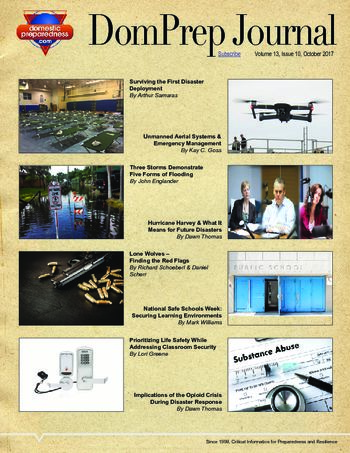
Author Archive

This expert guidance document was developed as a resource to provide healthcare epidemiologists working in acute-care hospitals with a high-level overview of incident management for infectious disease outbreaks and to prepare them to work within an emergency response framework. https://www.cambridge.org/core/journals/infection-control-and-hospital-epidemiology/article/outbreak-response-and-incident-management-shea-guidance-and-resources-for-healthcare-epidemiologists-in-united-states-acutecare-hospitals/8C035426B3C86E075BBB0AFFAE42F0AC/core-reader#

Outbreak Response and Incident Management: SHEA Guidance and Resources for Healthcare Epidemiologists in United States Acute-Care Hospitals
Domestic Preparedness
December 11, 2017
This expert guidance document was developed as a resource to provide healthcare epidemiologists working in acute-care hospitals with a high-level overview of incident management for infectious disease outbreaks and to prepare them to work within an emergency response framework. https://www.cambridge.org/core/journals/infection-control-and-hospital-epidemiology/article/outbreak-response-and-incident-management-shea-guidance-and-resources-for-healthcare-epidemiologists-in-united-states-acutecare-hospitals/8C035426B3C86E075BBB0AFFAE42F0AC/core-reader#

November 2017
Domestic Preparedness
November 29, 2017
Featured in this issue: Unmanned Aircraft Systems – On the Way to the Jetsons’ Era, By Charles J. Guddemi; Drones – Both a Force Multiplier & Headache, By Catherine L. Feinman; Protecting the Homeland From Nefarious Drone Use, By Richard Schoeberl & Kendall J. Smith; Critical Infrastructure Partnerships – Prioritizing

Mass Violence and Behavioral Health
Domestic Preparedness
November 21, 2017
This report focuses on how mass violence affects the behavioral health of adult and young (child and adolescent) survivors or witnesses of a mass violence incident. Public health, behavioral health, and emergency management professionals can use information provided to improve their disaster behavioral health preparedness plans. https://www.samhsa.gov/sites/default/files/dtac/srb-mass-violence-behavioral-health.pdf

Mass Violence and Behavioral Health
Domestic Preparedness
November 21, 2017
This report focuses on how mass violence affects the behavioral health of adult and young (child and adolescent) survivors or witnesses of a mass violence incident. Public health, behavioral health, and emergency management professionals can use information provided to improve their disaster behavioral health preparedness plans. https://www.samhsa.gov/sites/default/files/dtac/srb-mass-violence-behavioral-health.pdf

Wildfire Management Funding: Background, Issues, and FY2018 Appropriations
Domestic Preparedness
November 17, 2017
This report provides an overview of the accounts that fund wildfire management activities and historical wildfire management appropriations data, as well as information on FY2018 appropriations. https://fas.org/sgp/crs/misc/R45005.pdf

Wildfire Management Funding: Background, Issues, and FY2018 Appropriations
Domestic Preparedness
November 17, 2017
This report provides an overview of the accounts that fund wildfire management activities and historical wildfire management appropriations data, as well as information on FY2018 appropriations. https://fas.org/sgp/crs/misc/R45005.pdf

Critical Infrastructure Protection: DHS Risk Assessments Inform Owner and Operator Protection Efforts and Departmental Strategic Planning
Domestic Preparedness
November 7, 2017
The U.S. Government Accountability Office was asked to review the Department of Homeland Security’s (DHS) risk assessment practices for critical infrastructure. This report describes: (1) DHS’s risk assessment practices in 3 of 16 critical infrastructure sectors and private sector representatives’ views on the utility of this risk information; and (2)

Critical Infrastructure Protection: DHS Risk Assessments Inform Owner and Operator Protection Efforts and Departmental Strategic Planning
Domestic Preparedness
November 7, 2017
The U.S. Government Accountability Office was asked to review the Department of Homeland Security’s (DHS) risk assessment practices for critical infrastructure. This report describes: (1) DHS’s risk assessment practices in 3 of 16 critical infrastructure sectors and private sector representatives’ views on the utility of this risk information; and (2)

October 2017
Domestic Preparedness
October 25, 2017
Featured in this issue: Surviving the First Disaster Deployment, By Arthur Samaras; Unmanned Aerial Systems & Emergency Management, By Kay C. Goss; Three Storms Demonstrate Five Forms of Flooding, By John Englander; Hurricane Harvey & What It Means for Future Disasters, By Dawn Thomas; Lone Wolves – Finding the Red
Follow Us
Get Instant Access
Subscribe today to Domestic Preparedness and get real-world insights for safer communities.
ARchives
Follow Us
Get Instant Access
Subscribe today to Domestic Preparedness and get real-world insights for safer communities.


